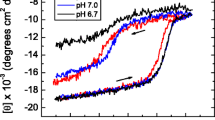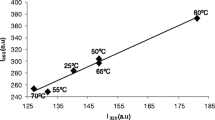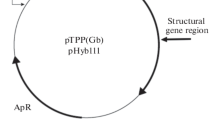Abstract
Prior to the exponential decrease of activity of a uricase from Candida sp. during storage at 37 °C, there was a plateau period of about 4 days at pH 7.4, 12 days at pH 9.2, and about 22 days in the presence of 30 μM oxonate at pH 7.4 or 9.2, but no degradation of polypeptides and no activity of resolved homodimers. To reveal determinants of the plateau period, a dissociation model involving a serial of conformation intermediates of homotetramer were proposed for kinetic analysis of the thermoinactivation process. In the dissociation model, the roles of interior noncovalent interactions essential for homotetramer integrity were reflected by an equivalent number of the artificial weakest noncovalent interaction; to avoid covariance among parameters, the rate constant for disrupting the artificial weakest noncovalent interaction was fixed at the minimum for physical significance of other parameters; among thermoinactivation curves simulated by numerical integration with different sets of parameters, the one for least-squares fitting to an experimental one gave the solution. Results found that the equivalent number of the artificial weakest noncovalent interaction primarily determined the plateau period; kinetics rather than thermodynamics for homotetramer dissociation determined the thermoinactivation process. These findings facilitated designing thermostable uricase mutants.







Similar content being viewed by others
Abbreviations
- DD:
-
The denatured homodimer
- H:
-
The nondenatured homodimer
- k 1 :
-
The disruption rate of the weakest interaction
- k −1 :
-
Reversal formation rate
- k −2 :
-
The rate for the association of two nondenatured homodimers into the homotetramer
- k 2 :
-
The rate for the denaturation of homodimer
- LSF:
-
Least-squares fitting
- m :
-
The equivalent number of the artificial weakest noncovalent interaction
- PAGE:
-
Polyacrylamide electrophoresis
- SDS-PAGE:
-
Sodium-dodecylsulfate polyacrylamide-electrophoresis
- T1 :
-
The dynamic level of the homotetramer tolerating no disruption of interior noncovalent interactions essential for homotetramer integrity
- Tm :
-
The dynamic level of representative conformational intermediate of the homotetramer (whose subscript indicated the conformational intermediate after the disruption of the mth interior noncovalent interaction in the dissociation pathway)
- TA:
-
The total activity
- T0.5 :
-
The temperature for reserving half of initial activity of an enzyme after the treatment for a customized time
References
Schlesinger N, Yasothan U, Kirkpatrick P (2011) Pegloticase. Nat Rev Drug Discov 10:17–18
Yang X, Yuan Y, Zhan C-G, Liao F (2012) Uricase as therapeutic agents to treat refractory gout: current states and future directions. Drug Dev Res 73:66–72
Dinnel J, Moore BL, Skiver BM, Bose P (2015) Rasburicase in the management of tumor lysis: an evidence-based review of its place in therapy. Core Evid 10:23–38
Liao F, Zhao Y, Zhao L, Tao J, Zhu X, Liu L (2006) Evaluation of a kinetic uricase method for serum uric acid assay by predicting background absorbance of uricase reaction solution with an integrated method. J Zhejiang Univ Sci B 7:497–502
Zhao Y, Yang X, Lu W, Liao H, Liao F (2009) Uricase based method for determination of uric acid in serum. Microchim Acta 164:1–6
Huang Y, Chen Y, Yang X, Zhao H, Hu X, Pu J, Liao J, Long G, Liao F (2015) Optimization of pH values to formulate the bireagent kit for serum uric acid assay. Biotechnol Appl Biochem 62:137–144
Liu Z, Lu D, Li J, Chen W, Liu Z (2009) Strengthening intersubunit hydrogen bonds for enhanced stability of recombinant urate oxidase from Aspergillus flavus:molecular simulations and experimental validation. Phys Chem Chem Phys 11:333–340
Liu X, Wen M, Li J, Zhai F, Ruan J, Zhang L, Li S (2011) High-yield expression purification characterization and structure determination of tag-free Candida utilis uricase. Appl Microbiol Biotechnol 92:529–537
Zhang C, Fan K, Luo H, Ma X, Liu R, Yang L, Hu C, Chen Z, Min Z, Wei D (2012) Characterization efficacy pharmacokinetics and biodistribution of 5 kDa mPEG modified tetrameric canine uricase variant. Int J Pharm 430:307–317
Yamamoto K, Kojima Y, Kikuchi T, Shigyo T, Sugihara K, Takashio M, Emi S (1996) Nucleotide sequence of the uricase gene from Bacillus sp.TB-90. J Biochem 119:80–84
Suzuki K, Sakasegawa S, Misaki H, Sugiyama M (2004) Molecular cloning and expression of uricase gene from Arthrobacter globiformis in Escherichia coli and characterization of the gene product. J Biosci Bioeng 98:153–158
Zhao Y, Zhao L, Yang G, Tao J, Bu Y, Liao F (2006) Characterization of a uricase from Bacillus fastidious ATCC26904 and its application to serum uric acid assay by a patented kinetic uricase method. Biotechnol Appl Biochem 45:75–80
Feng J, Wang L, Liu H, Yang X, Liu L, Xie Y, Liu M, Zhao Y, Li X, Wang D, Zhan C-G, Liao F (2015) Crystal structure of Bacillus fastidious uricase reveals an unexpected folding of the C-terminus residues crucial for thermostability under physiological conditions. Appl Microbiol Biotechnol 99:7973–7986
Zhao Y, Yang X, Li X, Bu Y, Deng P, Zhang C, Feng J, Xie Y, Zhu S, Yuan H, Yu M, Liao F (2009) Reversible inactivation of an intracellular uricase from Bacillus fastidiosus via dissociation of homotetramer into homodimers in solutions of low ionic strength. Biosci Biotechnol Biochem 73:2141–2144
Tian H, Guo Y, Gao X, Yao W (2013) PEGylation enhancement of pH stability of uricase via inhibitive tetramer dissociation. J Pharm Pharmacol 65:53–63
Hibi T, Hayashi Y, Fukada H, Itoh T, Nago T, Nishiya Y (2014) Intersubunit salt bridges with a sulfate anion control subunit dissociation and thermal stabilization of Bacillus sp. TB-90 urate oxidase. Biochemistry 53:3879–3888
Kotb E (2015) Characterization of a thermostable uricase isolated from Bacillus firmus DWD-33 and its application for uric acid quantification in human serum. Protein Pept Lett 22:402–409
Hibi T, Kume A, Kawamura A, Itoh T, Fukada H, Nishiya Y (2016) Hyperstabilization of tetrameric bacillus sp. tb-90 urate oxidase by introducing disulfide bonds through structural plasticity. Biochemistry 55:724–732
Bayol A, Dupin P, Boe JF, Claudy P, Létoffé JM (1995) Study of pH and temperature-induced transitions in urate oxidase (Uox-EC1.7.3.3) by microcalorimetry (DSC) size exclusion chromatography (SEC) and enzymatic activity experiments. Biophys Chem 54:229–235
Poltorak OM, Chukhray ES, Torshin IY (1998) Dissociative thermal inactivation stability and activity of oligomeric enzymes. Biochemistry (Mosc) 63:303–311
Chukhrai ES, Atyaksheva LF (2010) A physical chemistry view of the activity stability and adsorption properties of enzymes. Russ J Phys Chem A 84:709–722
Feng J, Liu H, Yang X, Gao A, Liao J, Feng L, Pu J, Xie Y, Long G, Li Y, Liao F (2013) Comparison of activity indexes for recognizing enzyme mutants of higher activity with uricase as model. Chem Cent J 7:69. doi:10.1186/1752-153X-7-69
Bradford MM (1976) A rapid and sensitive method for the quantitation of microgram quantities of protein utilizing the principle of protein-dye binding. Anal Biochem 72:248–254
Yang X, Liu B, Sang Y, Yuan Y, Pu J, Liu Y, Li Z, Feng J, Xie Y, Tang R, Yuan H, Liao F (2010) Kinetic analysis of the lactate-dehydrogenase-coupled reaction process and measurement of alanine transaminase by an integration strategy. Anal Sci 26:1193–1198
Qi M, Zhang GP (2001) An investigation of model selection criteria for neural network time series forecasting. Eur J Oper Res 132:666–680
Fridovich I (1965) The competitive inhibition of uricase by oxonate and by related derivatives of S-triazines. J Biol Chem 240:2491–2494
Chen Y, Jiang H, Peng F, Liao J, Yang X, Liao F (2012) Formulation and storage of Bacillus fastidious uricase as diagnosis enzyme. J Chongqing Med Univ 37:228–231
Cleland WW (1979) Optimizing coupled enzyme assays. Anal Biochem 99:142–145
Aguda BD (1996) Emergent properties of coupled enzyme reaction systems 1. Switch Clust Behav Biophys Chem 61:1–7
Kumar A, Josić K (2011) Reduced models of networks of coupled enzymatic reactions. J Theor Biol 278:87–106
Laidler KJ (1987) Chemical kinetics, 3rd edn. Harper & Row, New York
Houston PL (2001) Chemical kinetics and reaction dynamics. McGraw-Hill, New York
Kosasih HJ, Last K, Rogerson FM, Golub SB, Gauci SJ, Russo VC, Stanton H, Wilson R, Lamande SR, Holden P, Fosang AJ (2016) A disintegrin and metalloproteinase with thrombospondin motifs-5 (ADAMTS-5) forms catalytically active oligomers. J Biol Chem 291:3197–3208
Tamulaitis G, Rutkauskas M, Zaremba M, Grazulis S, Tamulaitiene G, Siksnys V (2015) Functional significance of protein assemblies predicted by the crystal structure of the restriction endonuclease BsaWI. Nucleic Acids Res 43:8100–8110
Satagopan S, Chan S, Perry LJ, Tabita FR (2014) Structure-function studies with the unique hexameric form II ribulose-15-bisphosphate carboxylase/oxygenase (Rubisco) from Rhodopseudomonas palustris. J Biol Chem 289:21433–21450
Ronchi VP, Klein JM, Edwards DJ, Haas AL (2014) The active form of E6-associated protein (E6AP)/UBE3A ubiquitin ligase is an oligomer. J Biol Chem 289:1033–1048
Vitlin Gruber A, Zizelski G, Azem A, Weiss C (2014) The Cpn10(1) co-chaperonin of A, thaliana functions only as a hetero-oligomer with Cpn20. PLoS One 9:e113835
Acknowledgments
The work was supported by National Natural Science Foundation of China (Nos. 30672139, 31570862, 21402108), Sciences and Technology Commission of Yuzhong District of Chongqing (No. 20130135) and Education Ministry of China (No. 20125503110007). Miss Xin Wang prepared samples for Tandem MS–MS and Edman degradation analyses. The mutants of Bacillus fastidiosus uricase bearing plateau periods were already included in an invention patent application in China (Application No. 201610093491.8).
Author information
Authors and Affiliations
Corresponding author
Ethics declarations
Conflicts of interest
The authors declare no conflicts of interest.
Ethical Approval
This article does not contain any studies with human participants or animals performed by any of the authors.
Additional information
Jing Wu and Xiaolan Yang have contributed equally to this work.
Electronic supplementary material
Below is the link to the electronic supplementary material.
Rights and permissions
About this article
Cite this article
Wu, J., Yang, X., Wang, D. et al. A Numerical Approach for Kinetic Analysis of the Nonexponential Thermoinactivation Process of Uricase. Protein J 35, 318–329 (2016). https://doi.org/10.1007/s10930-016-9675-9
Published:
Issue Date:
DOI: https://doi.org/10.1007/s10930-016-9675-9




